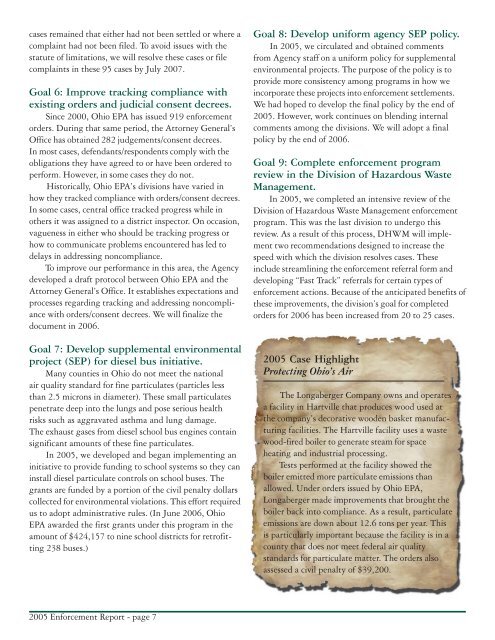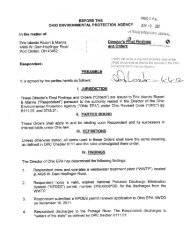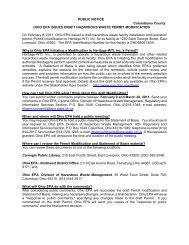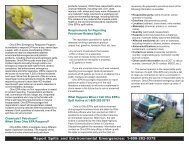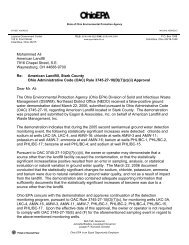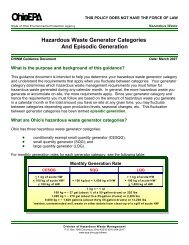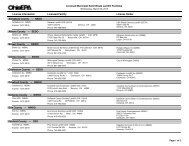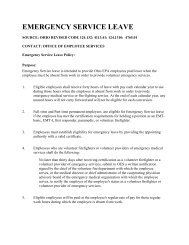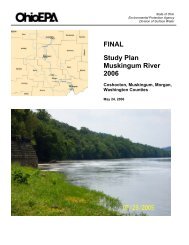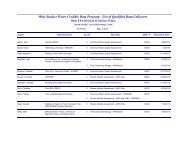Enforcement Report 2.pmd - Ohio EPA
Enforcement Report 2.pmd - Ohio EPA
Enforcement Report 2.pmd - Ohio EPA
Create successful ePaper yourself
Turn your PDF publications into a flip-book with our unique Google optimized e-Paper software.
cases remained that either had not been settled or where a<br />
complaint had not been filed. To avoid issues with the<br />
statute of limitations, we will resolve these cases or file<br />
complaints in these 95 cases by July 2007.<br />
Goal 6: Improve tracking compliance with<br />
existing orders and judicial consent decrees.<br />
Since 2000, <strong>Ohio</strong> <strong>EPA</strong> has issued 919 enforcement<br />
orders. During that same period, the Attorney General’s<br />
Office has obtained 282 judgements/consent decrees.<br />
In most cases, defendants/respondents comply with the<br />
obligations they have agreed to or have been ordered to<br />
perform. However, in some cases they do not.<br />
Historically, <strong>Ohio</strong> <strong>EPA</strong>’s divisions have varied in<br />
how they tracked compliance with orders/consent decrees.<br />
In some cases, central office tracked progress while in<br />
others it was assigned to a district inspector. On occasion,<br />
vagueness in either who should be tracking progress or<br />
how to communicate problems encountered has led to<br />
delays in addressing noncompliance.<br />
To improve our performance in this area, the Agency<br />
developed a draft protocol between <strong>Ohio</strong> <strong>EPA</strong> and the<br />
Attorney General’s Office. It establishes expectations and<br />
processes regarding tracking and addressing noncompliance<br />
with orders/consent decrees. We will finalize the<br />
document in 2006.<br />
Goal 7: Develop supplemental environmental<br />
project (SEP) for diesel bus initiative.<br />
Many counties in <strong>Ohio</strong> do not meet the national<br />
air quality standard for fine particulates (particles less<br />
than 2.5 microns in diameter). These small particulates<br />
penetrate deep into the lungs and pose serious health<br />
risks such as aggravated asthma and lung damage.<br />
The exhaust gases from diesel school bus engines contain<br />
significant amounts of these fine particulates.<br />
In 2005, we developed and began implementing an<br />
initiative to provide funding to school systems so they can<br />
install diesel particulate controls on school buses. The<br />
grants are funded by a portion of the civil penalty dollars<br />
collected for environmental violations. This effort required<br />
us to adopt administrative rules. (In June 2006, <strong>Ohio</strong><br />
<strong>EPA</strong> awarded the first grants under this program in the<br />
amount of $424,157 to nine school districts for retrofitting<br />
238 buses.)<br />
2005 <strong>Enforcement</strong> <strong>Report</strong> - page 7<br />
Goal 8: Develop uniform agency SEP policy.<br />
In 2005, we circulated and obtained comments<br />
from Agency staff on a uniform policy for supplemental<br />
environmental projects. The purpose of the policy is to<br />
provide more consistency among programs in how we<br />
incorporate these projects into enforcement settlements.<br />
We had hoped to develop the final policy by the end of<br />
2005. However, work continues on blending internal<br />
comments among the divisions. We will adopt a final<br />
policy by the end of 2006.<br />
Goal 9: Complete enforcement program<br />
review in the Division of Hazardous Waste<br />
Management.<br />
In 2005, we completed an intensive review of the<br />
Division of Hazardous Waste Management enforcement<br />
program. This was the last division to undergo this<br />
review. As a result of this process, DHWM will implement<br />
two recommendations designed to increase the<br />
speed with which the division resolves cases. These<br />
include streamlining the enforcement referral form and<br />
developing “Fast Track” referrals for certain types of<br />
enforcement actions. Because of the anticipated benefits of<br />
these improvements, the division’s goal for completed<br />
orders for 2006 has been increased from 20 to 25 cases.<br />
2005 Case Highlight<br />
Protecting <strong>Ohio</strong>’s Air<br />
The Longaberger Company owns and operates<br />
a facility in Hartville that produces wood used at<br />
the company’s decorative wooden basket manufacturing<br />
facilities. The Hartville facility uses a waste<br />
wood-fired boiler to generate steam for space<br />
heating and industrial processing.<br />
Tests performed at the facility showed the<br />
boiler emitted more particulate emissions than<br />
allowed. Under orders issued by <strong>Ohio</strong> <strong>EPA</strong>,<br />
Longaberger made improvements that brought the<br />
boiler back into compliance. As a result, particulate<br />
emissions are down about 12.6 tons per year. This<br />
is particularly important because the facility is in a<br />
county that does not meet federal air quality<br />
standards for particulate matter. The orders also<br />
assessed a civil penalty of $39,200.


